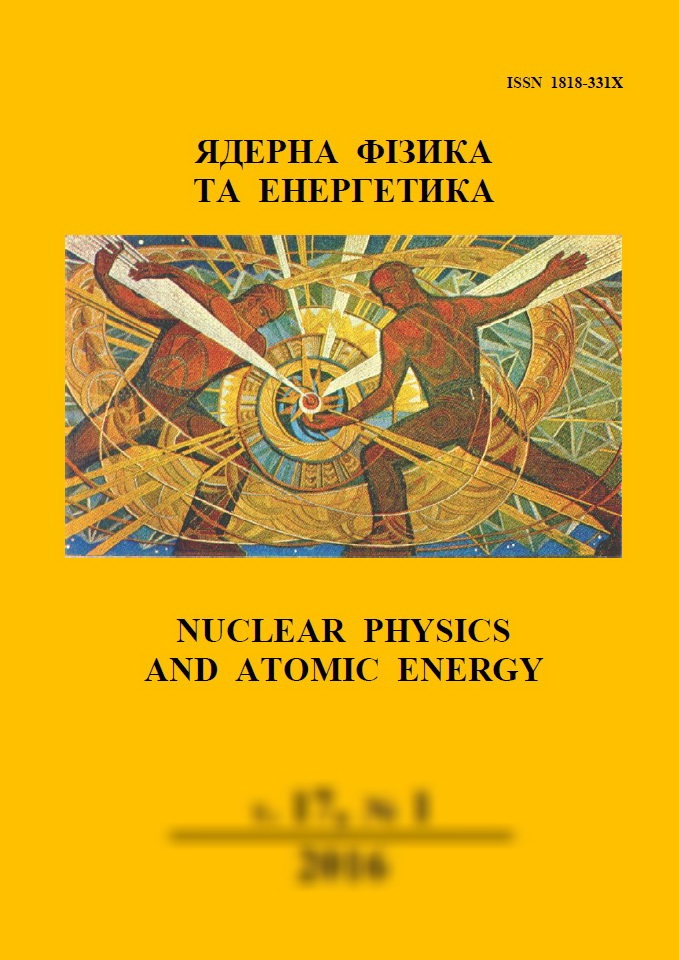 |
Ядерна фізика та енергетика
Nuclear Physics and Atomic Energy
ISSN:
1818-331X (Print), 2074-0565 (Online)
Publisher:
Institute for Nuclear Research of the National Academy of Sciences of Ukraine
Languages:
Ukrainian, English, Russian
Periodicity:
4 times per year
Open access peer reviewed journal
|
Nucl. Phys. At. Energy 2015, volume 16, issue 1, pages 90-97.
Section: Engineering and Methods of Experiment.
Received: 11.02.2015; Accepted: 19.03.2015; Published online: 20.04.2015.
 Full Text (ua)
Full Text (ua)
https://doi.org/10.15407/jnpae2015.01.090
Thickness measurement of the stripper foil using modified nuclear-analytical method
V. I. Soroka, V. V. Ostashko*, V. А. Onischuk, Е. М. Mozhzhukhin, M. V. Artsimovich, D. A. Kushpii, I. V. Posmitiukh, A. F. Sharov, A. A. Shevchuk
Institute for Nuclear Research, National Academy of Sciences of Ukraine, Kyiv, Ukraine
*Corresponding author. E-mail address:
ostashko@kinr.kiev.ua.
Abstract:
Thickness and thickness uniformity measurements of thick, self-supporting, carbon foil as stripper target in tandem
accelerator have been performed. Non-destroying, nuclear-analytical method with accelerated to 3.5 MeV proton is used.
The method was modified for achievement of higher accuracy and sensitivity and for the expansion of the scope of application.
Introduction of monitor-interrupter as an additional element in the backscattering standard scheme changes
the procedure of experimental data obtaining, and simplifies the calculations formula. Designs of the interrupter and the
targets holder are described. Mean thickness of the stripper target was found to be 7.3⋅1017 аtoms/cm2 (~ 9.5 μg/сm2). Such thickness for protons, in comparison with optimum one is too high. The thickness uniformity does not exceed the experiment error.
Keywords:
tandem accelerator, carbon stripper target, foils thickness, backscattering spectrometry, modified method.
References:
1. K. Shima, S. Ishii, T. Takahashi, I. Sugai. Optimum thickness of carbon stripper foils in tandem accelerator in view of transmission and lifetime. Nucl. Instrum. Methods Phys. Res. A 460 (2001) 233.
https://doi.org/10.1016/S0168-9002(00)01074-3
2. G. Dollinger, P. Maier-Komor. Stripper foil requirements for optimum ion transmission at the Munich MP-tandem.
Nucl. Instrum. Methods Phys. Res. A 282 (1989) 153.
https://doi.org/10.1016/0168-9002(89)90130-7
3. L. Hao-Lin, W.F. Sommer, M.J. Borden. Review of carbon stripper foil lifetime. Nucl. Instrum. Methods
Phys. Res. A 362 (1995) 239.
https://doi.org/10.1016/0168-9002(95)00199-9
4. C. Wagemans. On the necessity of alternative methods to determine sample thicknesses and masses. Nucl.
Instrum. Methods Phys. Res. A 282 (1989) 4.
https://doi.org/10.1016/0168-9002(89)90102-2
5. J.W. Mayer, E. Rimini (Coordinating Editors). Ion Beam Handbook for Material Analysis (New York: Academic
Press, 1977).
Google Books
6. W.K. Chu, J.W. Mayer, M.A. Nicolet. Backscattering spectrometry (New York: Academic Press, 1978).
7. D.A. Kushpii, A.S. Vasyl'kivs'kyi, A.G. Berezovs'kyi. KINR Annual Report-2011 (Kyiv, 2012) p. 75. (Ukr)
https://kinr.kyiv.ua/Annual_report/report11.pdf
8. M.V. Artsimovich, I.F. Mogilnik, V.I. Soroka. The measuring and calculating complex “Kanion” for researches in the
field of the applied nuclear physics. Preprint KINR-97-8 of Institute for Nuclear Research (Kyiv, 1997) 18 p.
9. C.W. Reich, G.C. Phillips, K.R. Russell. Scattering of protons from C12. Phys. Rev. 104(1) (1956) 143.
https://doi.org/10.1103/PhysRev.104.143
10. V.I. Soroka, V.A. Onyshchuk, E.M. Mozhzhukhin et al. Resonance proton scattering use for the beam parameters control of the electrostatic accelerators. Nucl. Phys. At. Energy 14(4) (2013) 404. (Ukr)
https://jnpae.kinr.kyiv.ua/14.4/Articles_Pdf/jnpae-2013-14-0404-Soroka.pdf
